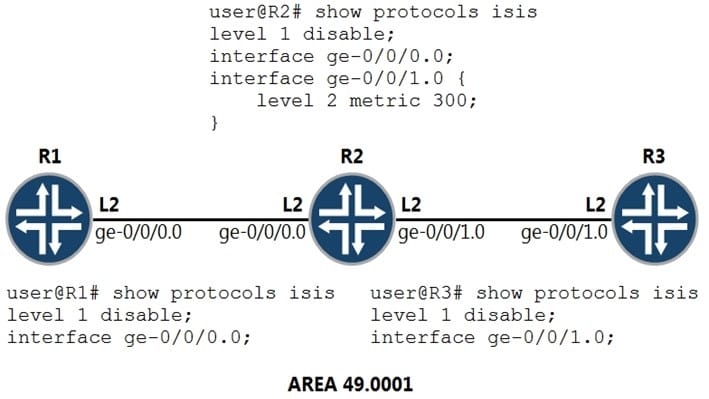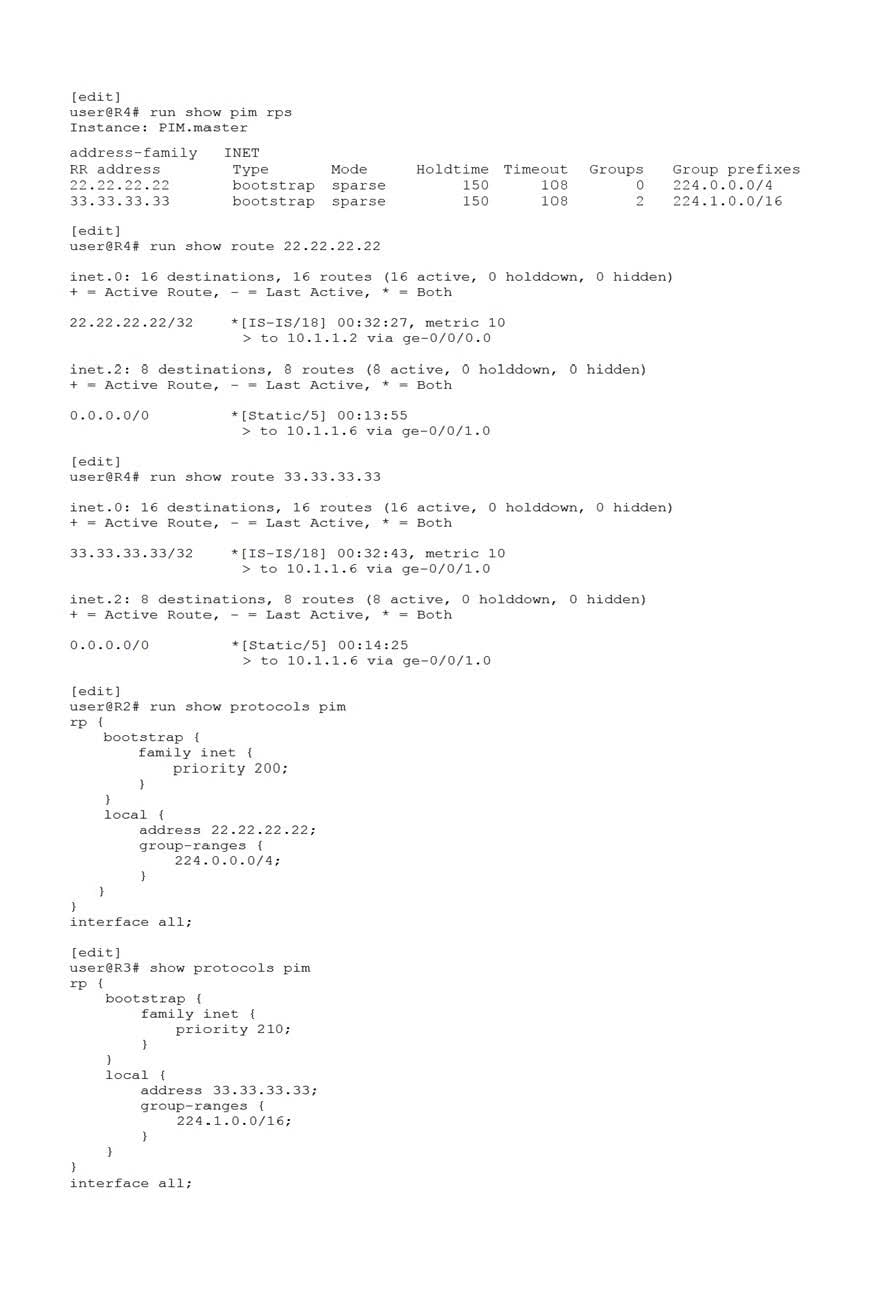Exam Details
Exam Code
:JN0-663Exam Name
:Service Provider Routing and Switching, Professional (JNCIP-SP)Certification
:Juniper CertificationsVendor
:JuniperTotal Questions
:96 Q&AsLast Updated
:Aug 19, 2025
Juniper Juniper Certifications JN0-663 Questions & Answers
-
Question 81:

Referring to the exhibit, which OSPFv3 configuration is implemented on router R1?
A. set protocols ospf3 area 0.0.0.0 interface ge-0/0/0.0 set protocols ospf3 area 0.0.0.1 interface ge-0/0/1.0 set protocols ospf3 area 0.0.0.1 interface ge-0/0/0.0
B. set protocols ospf3 area 0.0.0.0 interface ge-0/0/0.0 set protocols ospf3 area 0.0.0.1 interface ge-0/0/1.0 set protocols ospf3 area 0.0.0.1 virtual-link neighbor-id 172.16.1.2
C. set protocols ospf3 area 0.0.0.0 interface ge-0/0/0.0 set protocols ospf3 area 0.0.0.1 interface ge-0/0/1.0 set protocols ospf3 area 0.0.0.1 interface ge-0/0/0.0 secondary
D. set protocols ospf3 area 0.0.0.0 interface ge-0/0/0.0 set protocols ospf3 area 0.0.0.1 interface ge-0/0/1.0 set protocols ospf3 area 0.0.0.1 interface ge-0/0/0.0 interface-type p2p
-
Question 82:
Which two types of LSAs have an area scope? (Choose two.)
A. Type 2
B. Type 5
C. Type 11
D. Type 7
-
Question 83:

Referring to the exhibit, traffic sent from CE-A2 to PE3 does not loop back to CE-A2 through PE2.
Winch two EVPN functions accomplish this task? (Choose two.)
A. multicast ingress replication
B. aliasing
C. split horizon
D. designated forwarder election
-
Question 84:

Referring to the exhibit, what will the IS-IS cost be for R1 to reach R3?
A. 73
B. 20
C. 301
D. 310
-
Question 85:

Referring to the exhibit, which two statements are correct? (Choose two.)
A. R2 stops sending LSAs into the network.
B. The OSPF interface metrics on R2 are all set to 65535.
C. R1 will never forward transit traffic through R2.
D. Transit traffic from R1 to R4 will traverse R3.
-
Question 86:

R4 is directly connected to both RPs (R2 and R3). R4 is currently sending all joins upstream to R3 but you want to load balance the joins between both RPs.
Referring to the exhibit, which configuration change will solve this issue?
A. Configure the join-load-balance parameter under PIM on R4.
B. Configure the default route in inet.2 on R4 from R3 as the next hop to both R3 and R2.
C. Configure the group-range parameter to be the same on R2 and R3.
D. Configure the bootstrap priority on R2 to be the same as R3.
-
Question 87:
Which two statements about wide and narrow metrics used in IS-IS are correct? (Choose two.)
A. Wide metrics are enabled with the wide-metrics-only parameter under protocols isis hierarchy.
B. Narrow metrics are enabled by default and use 8 bits in TLVs to send information.
C. Wide metrics are sent by default and use 24 bits in TLVs to send information.
D. Disabling narrow metrics results in external routes being leaked from L1 to L2 areas automatically.
-
Question 88:
What information is stored in a VRF table for a BGP Layer 2 VPN? (Choose three.)
A. Layer 2 encapsulation
B. local site ID
C. remote interface of local CE device
D. logical interlace provisioned to local CE device
E. label-switched path
-
Question 89:

You are provisioning Layer 2 circuits between sites CE1, CE2, and CE3.
Referring to the exhibit, which statement is true?
A. A point-to-multipoint LSP must be created between sites.
B. Each site must have only one VLAN configured to the PE.
C. Site PE1 must have a point-to-multipoint link configured towards the core.
D. Two VLANs must be configured from PE 1 to CE 1.
-
Question 90:

Referring to the exhibit, which two statements about route reflectors are correct? (Choose two.)
A. RR1 advertises routes learned from Client1 to RR2 with itself as the next hop.
B. RR2 advertises routes learned from Client3 to EBGP2 with itself as the next hop.
C. RR1 and RR2 need the same cluster ID to exchange routes learned from their clients.
D. RR2 adds its cluster ID when advertising routes from Client4 to Client3.
Related Exams:
JN0-102
Internet Associate, Junos(JNCIA-Junos)JN0-104
Junos, Associate (JNCIA-Junos)JN0-105
Junos, Associate (JNCIA-Junos)JN0-1101
Juniper Networks Certified Design Associate (JNCDA)JN0-1103
Design, Associate (JNCIA-Design)JN0-130
Juniper networks Certified internet specialist.e(jncis-e)JN0-1301
Data Center Design, Specialist (JNCDS-DC)JN0-1302
Data Center Design Specialist (JNCDS-DC)JN0-1331
Security Design, Specialist (JNCDS-SEC)JN0-1332
Security Design, Specialist (JNCDS-SEC)
Tips on How to Prepare for the Exams
Nowadays, the certification exams become more and more important and required by more and more enterprises when applying for a job. But how to prepare for the exam effectively? How to prepare for the exam in a short time with less efforts? How to get a ideal result and how to find the most reliable resources? Here on Vcedump.com, you will find all the answers. Vcedump.com provide not only Juniper exam questions, answers and explanations but also complete assistance on your exam preparation and certification application. If you are confused on your JN0-663 exam preparations and Juniper certification application, do not hesitate to visit our Vcedump.com to find your solutions here.